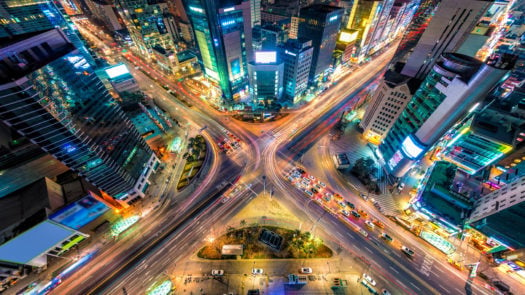Published on: October 11th, 2018
Last updated: March 21st, 2024
The best time to visit South Korea for the cherry blossoms is between late March to mid-April. From September to November, colourful autumn leaves and traditional festivals await. The best time to travel to South Korea for the snow is from December to February.
A snowy getaway in the mountains, an island escape in Jeju, or a trip to capture the Sakura season in Seoul — the best time to visit South Korea depends entirely on what you want to do when you arrive.
South Korea’s four distinct seasons cater to all types of traveller, offering different perks year-round. Keep in mind that monsoon season typically runs from July to August; this is also when there are fewer crowds at most sightseeing spots.
The Top Things to do in South Korea
Whether you are in search of cutting-edge culture, outdoor adventure, big city life or an escape from it, South Korea is truly a destination that has it all. Here’s when to visit South Korea to enjoy your favourite activities and events.
See the Cherry Blossoms
The best time to see cherry blossoms in South Korea is during the spring months from the end of March to mid-April. Many travellers looking to experience Asia’s cherry blossom think of Japan; however, South Korea is a great alternative. For the best cherry blossom views, visit Seoul’s Yeouido Spring Flower Festival or Busan’s Jinhae Gunhangje Cherry Blossom Festival. On Jeju Island, Seongeup Folk Village showcases the pastel colours in an authentic and charming way.
See the Autumn Leaves
September to November is the best time to visit South Korea to see autumn leaves. The leaves change in colour, with stunning shades of orange and red appearing all over the country. In September, chilly autumnal temperatures can follow some of the hottest days of the year, so it's worth packing a few extra layers. October has nearly perfect weather and is a great time to enjoy the array of reds, oranges and yellows appearing across South Korea. In November, festivals such as the Seoul Lantern Festival and Seoul Kimchi Festival complement mild temperatures and natural beauty.
Winter sports
December to February is South Korea’s winter, which is cold but cosy. This is the best time to visit South Korea if you are looking enjoy some winter sports, such as skiing and snowboarding. Cooler temperatures also mean that points of interest will be far less crowded than usual. If you need to escape the cold for a while, head to one of South Korea’s many jjimjilbangs - traditional Korean spas complete with saunas and thermal baths.
Festivals and culture
As well as being the best time of year for South Korea’s cherry blossom, many exciting festivals take place between March and May. In March, Jeju Fire Festival celebrates the arrival of Spring. Farmers on Jeju Island set their pastures alight to kill old grass and eliminate pests before cattle and horses start grazing again. Daljip, or moon houses, are also burned to help fulfil villagers’ prayers for good fortune. The fascinating Jindo Miracle Sea Road Festival occurs between the end of April and early May. During this time, an incredible natural phenomenon allows festival-goers to walk straight through the middle of the parted Jindo Sea.
Where to Stay in South Korea
What season to avoid?
Monsoon season
In July, rainy season means that the whole of South Korea feels uncomfortably damp and muggy. August brings scorching temperatures alongside torrential rains. It’s also the holiday season for most Korean schools and universities, meaning it can get extremely crowded. South Korea experiences one to three typhoons per year, with most of them passing over the country in August, so this time of year is best avoided.
Seollal (Lunar New Year) and Chuseok
South Korea’s lunar new year, Seollal, is celebrated at some point in either January or February. Chuseok, a Korean harvest festival, falls between September and October. During both festivals, many South Koreans go home to see their families, making travelling around the country quite difficult. Many attractions are also closed during these times, so Seoul becomes quite quiet. As both celebrations depend on the lunar calendar, their dates change slightly each year. It’s a good idea to check whether your planned travel dates coincide with either festival before you book your trip.
Our Team's Favourite Trips to South Korea
Whatever you want from your trip to South Korea, our team of expert travel designers are ready to help.















